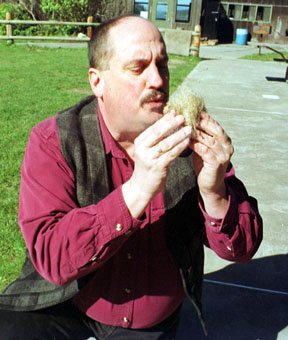Imagine being lost in a creepy, Blair Witch-esque woods. You feel the panic build up from your gut as you trudge blindly through the prickly bushes, only to find that you’ve walked in a giant circle.
You’re all alone. It’s getting dark and raindrops start falling from the dark canopy of branches above you. All you have is a coat and the clothes on your back.
So what do you do?
You would know, if you took a class from Frank and Karen Sherwood of Earthwalk Northwest. The Issaquah couple teach courses all over Western Washington in outdoor survival techniques, primitive living, identifying wild edible plants, rope making, flintnapping, coastal foraging, and bow and arrow making.
This weekend the Sherwoods are teaching their three-day course in survival techniques at Deception Pass State Park’s Environmental Learning Center on Whidbey Island.
With the proper education, the Sherwoods say it’s very possible to survive for a great deal of time in many environments without any provisions. Western Washington is one of the more survivable areas because of the abundance of water and vegetation.
“The earth provides for all our needs,” Karen said. “We just need to recognize how to utilize safely and appropriately the gifts from nature.”
Fire starting is one of the basic survival skills the Sherwoods teach.
It takes Frank just a few minutes to start a fire with a few rough pieces of wood and a thin cord attached to a bow. He wraps the bow around a stout piece of a branch with a slightly sharpened end. As he draws the bow back and forth, he presses the twirling wood into a board-like piece of wood with a carved-out area. Super-heated pieces of wood dust fall through a small crack in the wood to dry plant fibers below.
Soon, the fibers start smoking. Frank picks up the smokey bundle and blows on it until it bursts into flame.
Karen, who has a background in botany, teaches techniques in rope or cordage making and identifying wild edible plants. She can make a thin, strong cord from a stick of dogbane in a matter of five or ten minutes. She crushes the hollow stick and opens it up, pulling back the inner bark. She quickly braids the fibrous material into a thin rope with a method called reverse wrap.
The thin rope can be used for any number of things, including baskets and a bow for fire making or shooting arrows.
During the class at Deception Pass, Karen said she will teach the students to identify about 25 wild edible plants during interpretive walks and many more in a slide presentation. They include such well-known wild plants as dandelion, salal, plantain, Oregon grape, fir needles, chickweed and all sorts of berries. One of the most useful and nutritious plant, she said, is stinging nettle.
“Nettle needs to be prepared property,” she said, which means boiling the young leaves to remove the stinging property. The plant also makes superior rope.
In addition, Karen explained that coastal areas provide some of the most nutritious foods in nature. There are dozens of kinds of edible seaweeds, sea vegetables and shellfish.
In the survival course, the Sherwoods also teach shelter building, making stone knives and cutting tools, and safe water collecting. Frank said a student usually volunteers to sleep overnight in a shelter that the class builds.
“It’s really a full weekend,” Frank said. “We’re really busy from eight in the morning to nine at night.”
Both Frank and Karen have decades of experience in outdoor survival and related studies. While they are both Washington natives, they got their start in learning the unique skills at the well-known Tracker School on the East Coast.
Frank started out as a student at the Tracker School and found he loved it so much he took all the advanced courses. Eventually, founder Tom Brown, Jr., offered him a job. Then Karen, who was studying botany at the University of Washington, flew out to visit Frank. Brown ended up offering her a job teaching wild foods collection.
About five years ago, the Sherwoods moved back to Washington with their daughters and founded Earthwalk. They teach their wide variety of courses every weekend and some weekdays from March until November.
Another nearby course that Karen teaches is a seaweed and coastal foraging on Lopez Island. She explains how to identify, harvest with sustainable techniques, preserve and prepare seaweeds, which she said are surprisingly tasty. One of her most popular treats is bullwhip kelp dills.
“My daughter always begs to open jars of bullwhip kelp,” she said. “If kids love them, they can’t be all bad.”



